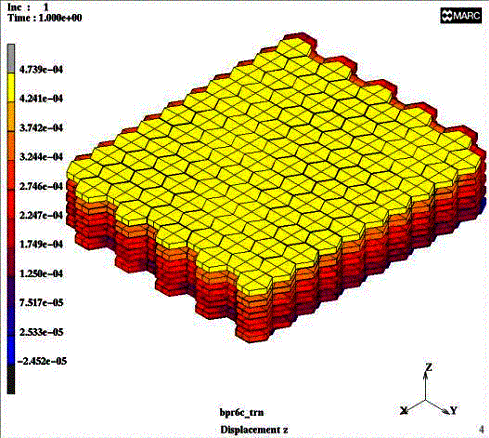|
Dr.
Kalpana S. Katti
Dr.
Dinesh R. Katti
Back to research pages of:
Dr. Kalpana
S. Katti
Dr.
Dinesh R. Katti
TV Interviews
June 2005
(9 MB)
Fall 2002
(6 MB)
|
|
PRINCIPAL
INVESTIGATORS
|
|
Dr.
Kalpana S. Katti
Dr.
Dinesh R. Katti
Department of Civil Engineering
North Dakota State University, Fargo, ND, USA
|
|
RESEARCH
OBJECTIVE: To develop multiscale models for predicting mechanical behavior of biological materials by bridging molecular, nano to macro scale mathematical models.
This research answers fundamental reasons for the extraordinary mechanical properties
like toughness and strength exhibited by biological nanocomposite nacre, the inner layer of seashells.
|
 |
 |
| |
|
3D Finite Element Simulation of Nacre Micro-Architecture
: Laminated
Structure: Inelastic Response
RESULTS: The purely laminated
structure of nacre as widely proposed would require the organic phase
in nacre to have an extraordinarily high yield stress of 400 MPa. (Our
discovery of platelet interlocks in 2005 will eliminate this
requirement - see below)
Katti, D. R. Katti, K. S., Sopp J., and Sarikaya, M., (2001)3D Finite Element
Modeling of Mechanical Response in Nacre-Based Hybrid Nanocomposites, J. Theo. Comp. Poly. Sci.
11 (5), pp. 397-404.
|
 |
 Mineral
Contacts Mineral
Contacts |
|
Modeling
The Organic-Inorganic Interfacial Nanoasperities (Platelet Roughness) RESULTS: The
nanoasperities or surface roughness has small contribution to the
elastic modulus of nacre and almost no contribution to its yield
stress. The roughness may provide better adhesion between organic
phase and the mineral phase and may provide some level of confinement
to the organics.
Katti, D.R., Pradhan, S.M., and Katti, K.S., (2004), Modeling The
Organic-Inorganic Interfacial Nanoasperities In A Model
Bio-Nanocomposite, Nacre,
J. Reviews on Advanced Materials Science, n 6, 162-168.
|
 |
 |
 |
|
|

Red
Abalone
Natural
Nanocomposite: The Seashell
Seashell is a
perfect natural armor
APPLICATIONS
- Design of high performance new
nanocomposites taking inspiration from biological materials
- Development of computational and
analytical tools for a truly simulation based design of materials
- Multiscale models for prediction of
mechanical response of a variety of biological materials for
applications in bioengineering
|
|
3D Finite Element Simulation of Nacre Micro-Architecture
: Laminated
Structure RESULTS: The elastic
modulus of the organic phase in nacre has a magnitude much higher than that
expected for typical proteins. The simulations predict elastic modulus of
the order of 15 to 20 GPa for the organic phase. (This was later confirmed
experimentally by another group)
Katti, Dinesh R. and Katti, Kalpana S.,
(2001) Modeling Microarchitecture and Mechanical Behavior of Nacre Using 3D
Finite Element Techniques, Part I: Elastic Properties, Journal of Materials
Science,
36 (6):1411-1417
|
| 
|
|
Modeling Mineral contacts in
aragonite platelets and relative rotation of platelets RESULTS: The
mineral contacts have minimal contribution to
the elastic modulus and yield stress of nacre. In fact, the mineral
contacts break long before nacre exhibits yielding. It appears the
mineral contacts are present for the biological growth of nacre.
Katti, K.S., Katti, D.R., Tang, J. and Sarikaya,
M.,(2005), Modeling Mechanical Responses In A Laminated Biocomposite,
Part II, Nonlinear Responses And Nuances Of Nanostructure,
Journal of Materials Science, n 40, 1749-1755
|

Scale bar: 50 nm |
|
Discovery of
Interlocks in Nacre: Key to Toughness and Strength
•RESULTS:
Interlocks
accurately predict the observed fracture toughness in nacre when
yield stress of organic is close to that of typical proteins about
5 MPa.
Interlocks predict mechanism of failure:
progressive failure of individual interlocks and large deformation
of organic.
They are the key to why nacre is tough
and strong
Katti, K.S., Katti, D.R., Pradhan, S.M., and Bhosle,
A., (2005), Platelet Interlocks are the Key to Toughness and Strength
in Nacre, Journal of Materials Research, v
20, n5, May, 1097-1100.
|
|










